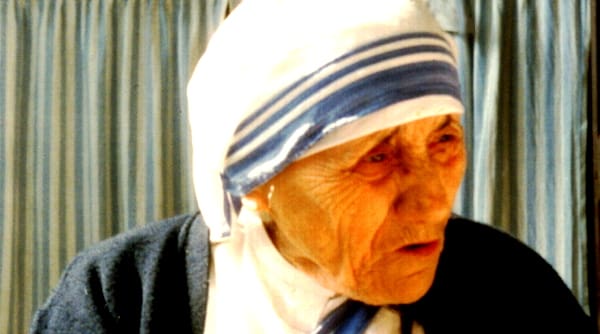
Saints have told of their spiritual torments and feelings of abandonment by God. In the sixteenth century, St. John of the Cross described the experience as “the dark night of the soul.” But we would be hard-pressed to find another saint who suffered a darkness so thick or a night so long as Mother Teresa suffered.
John of the Cross and others wrote poems and spiritual canticles to describe their sufferings in God’s absence and their frustrated longings for the embrace of his love. Mother Teresa never did. In fact, only her spiritual directors knew of her anguish. A few of her letters to them have been made public. And using lines drawn from these letters, we can piece together the stanzas of a sort of spiritual canticle depicting Mother Teresa’s dark night of the soul:
I did not know that love could make one suffer so much . . . of pain human but caused by the divine. The more I want him, the less I am wanted. I want to love him as he has not been loved, and yet there is that separation, that terrible emptiness, that feeling of absence of God.
They say people in hell suffer eternal pain because of the loss of God . . .
In my soul I feel just this terrible pain of loss, of God not wanting me, of God not being God, of God not really existing.
That terrible longing keeps growing, and I feel as if something will break in me one day.
Heaven from every side is closed.
I feel like refusing God.
Pray for me that I may not turn a Judas to Jesus in this painful darkness.
Never before perhaps in the history of the saints have we been given such an honest and plainspoken account of the dark night of a soul.
In Mother Teresa’s dark night, we can hear all the anguish of her century — the desolation of the poor, the cries of the unwanted children, of the atheist, of all those who can’t murmur a prayer or feel to love anymore. It was as if in some way she was bearing their sufferings. And in this she seemed in some way to be sharing too in the sufferings of Christ.
“In you, today, he wants to relive his complete submission to his Father,” she wrote in 1974 to a priest suffering his own spiritual blackness. “It does not matter what you feel, but what he feels in you . . . You and I must let him live in us and through us in the world.”
We now see these words as beautifully autobiographical, reflecting her awareness that in her emptiness and poverty she was being mystically grafted onto the life of Christ — being emptied as he was in assuming our humanity and being crucified as he was in offering himself for our sins.
After her death, it was disclosed that in her early missionary days, long before hearing her call to the poor, Mother Teresa had quietly made a private vow of spiritual espousal — to be all for Jesus and to refuse him nothing.
From her letters, we can see that she understood her darkness as an ordeal, a divine trial. In the dark night, her vow of self-offering was being put to the test. Would she really refuse him nothing, drink the cup her Lord drank, lay down her life as he had laid down his life, offer herself as he did, completely and without reserve? In her dark night, Jesus was claiming Mother Teresa for his own, pledging himself to his spiritual bride, pruning away her self-love and pride, purifying her in heart, mind, and intention, stripping away all that would keep her from total union with him.
And again using lines from her private letters, we can compose the final stanzas of Mother Teresa’s spiritual canticle, her response to her Lord and her dark night. These lines form a final prayer of self-oblation, an act of faith in which she makes herself a total gift — to share in Jesus’ Passion and in his burning thirst for souls:
For my meditation I am using the Passion of Jesus.
I am afraid I make no meditation, but only look at Jesus suffer and keep repeating,
Let me share with you this pain!
If my pain and suffering, my darkness and separation, give you a drop of consolation, my own Jesus, do with me as you wish.
I am your own.
Imprint on my soul and life the suffering of your heart.
If my separation from you brings others to you . . .
I am willing with all my heart to suffer all that I suffer. Your happiness is all that I want . . .
I have begun to love my darkness, for I believe now that it is a part, a very small part, of Jesus’ darkness and pain on the earth.
I want to satiate your thirst with every single drop of blood that you can find in me. Please do not take the trouble to return soon.
I am ready to wait for you for all eternity.
Following St. Thérèse into the Night and Dawn
Jesus came for her on September 5, 1997. She had been an apostle of joy and light in the dark final hours of the second Christian millennium.
She died almost one hundred years to the day after her patron St. Thérèse, the Little Flower of Lisieux. And their lives form spiritual brackets around the twentieth century. Thérèse, too, experienced a “night of nothingness” — on her deathbed, she heard demonic voices telling her that heaven was just a figment of her imagination.
Following Thérèse into this night of nothingness, Mother Teresa too sought the Holy Face of the Crucified in the crushed and the dying, walked the path of spiritual childhood in the small, ordinary realities of her days, and lived her life one little act of love at a time.
On the day Mother Teresa died, her sisters laid her in state beneath Our Lady of Fatima, a statue of the Blessed Mother depicted as she appeared to the children at Fatima. It was fitting in a way that no one could have known at the time.
Few knew that she had been guided all these years by apparitions and a voice heard one summer long ago. And few knew that she was trying to be a living expression of Mary’s love for her children, to show us the blessed fruit of Mary’s womb, Jesus. We can now see that Mother Teresa was among the firstfruits of the pope’s consecration of the world to Mary’s Immaculate Heart. The child called Gonxha “flower bud” — became the first bud of new Christian life, flowering from the century’s bloody soil of wars, famines, and persecutions.
Mother Teresa had followed the call of the gospel and done all that had been asked of her by Jesus and Mary in those earlier visions. They were visions for which her whole life had prepared her — and visions that she lived out for all generations to come. Kept secret during her lifetime, these things have been disclosed to us now in the early days of the new millennium so that we might understand more fully the meaning of Mother Teresa and the revolution of love that God was working in our midst.
She was our mother, coming to us in the dark night of our times to give us comfort and prove to us that we had not been orphaned by God. She taught us to call on our Father in all our desolations and diminishments, to cry out as she did — as children of his love, born of his desire, never out of his care, destined to love and be loved.
These were the lessons she was teaching every day in Nirmal Hriday. For the despised and unwanted, for those who had defiled themselves in sin and bad living, she wanted to prove the love of God, “to make the mercy of God very real and to induce the dying person to turn to God with filial confidence.”
Helping others to die, she was teaching us how to live — with the confidence of children finding their way back to the loving arms of their Father.
She was an apostle sent to us in our time of dying, to a culture in which death had become the last refuge of the living. Hers was a ministry of final moments and last chances. She believed in deathbed conversions, that we were never too old to learn the lessons of spiritual childhood, that on this side of death it was never too late for any of us — or for the world.
“I am convinced,” she said, “that even one moment is enough to ransom an entire miserable existence, an existence perhaps believed to be useless.”
She once said, “All of us are but his instruments, who do our little bit and pass by.” The little bit she did, she did with grace. But what she accomplished in her life was only partial. The accomplishments of the saints always are. They await their fulfillment in the lives of those who follow, in your life and in mine.
She turned our heads as she passed by, made us want to come and see what she saw, to follow where she was going.
+
This article was adapted from a chapter in The Love that Made Mother Teresa by David Scott which is available from Sophia Institute Press. 
Art for this post on the long dark night of Mother Teresa: Modified detail of Mother Teresa, Evert Odekerken, 1988, CCA 2.5 Generic, Wikimedia Commons. Cover of The Love That Made Mother Teresa used with permission.
Read more on Mother Teresa’s dark night on Spiritual Direction HERE.



